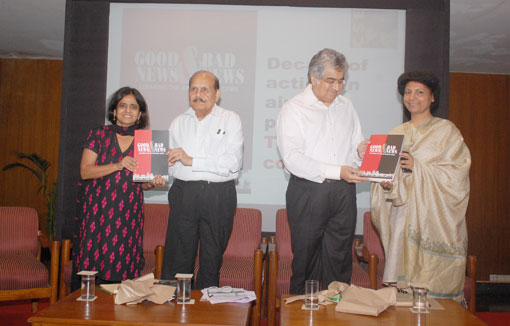
The axe and human civilisation
The use and abuse of wood is a major theme in the history of humankind according to a new book, A Forest Journey

The use and abuse of wood is a major theme in the history of humankind according to a new book, A Forest Journey

The Northern model of conserving tropical forests by completely eleminating humans from them will spell ecological disaster, and may aimed more at protecting the agricultural export markets of developed countries than enhancing global biodiversity

A new anti cancer drug seeks to starve cancerous cells to death
THE GLOBAL Environment Facility (GEF) meeting in Beijing recently marked the beginning of the first year after Rio. And it set the tone for the green world order of tomorrow -- a world in which

Vernacular comics, literary primers, a newsletter called Leaves: that's the way to teach those in Asia who've never had the chance

A Delhi based agency has improved the standard of living of a Himachal Pradesh village by providing it simple devices at subsidised rates
By Devinder Sharma Union Finance Minister P Chidambaram should address the woes of those ailing farmers in the budget. General elections are around the corner. It is therefore more of a political compulsion than the requirements of a prudent fiscal policy that should have automatically diverted public funds for the ailing agrarian sector. Unfortunately, the game plan all these years has been to ignore agriculture and instead pamper the bloated rich of big business to grow richer. No budget is complete without the Finance Minister reminding the country, with possibly a catchy phrase thrown-in, the Herculean task his budget will perform in addressing the agrarian crisis. P Chidambaram is no exception. He often quotes a couplet from the writings of some of the best-known poets, saints and thinkers of south India. After all, 60 per cent of the population is still directly engaged in farming. Despite all these efforts to rescue agriculture, the annual budget has truly been a carnival for the rich and beautiful. As the veteran economist Kamal Nayan Kabra reminds us: "Indeed, the corporate income tax foregone by the government is trivially less than the total amount spent by both the central government and the 28 state governments on all rural development schemes.' Accordingly, in 2004-05 Rs 2.06 lakh crore was the revenue loss from the numerous tax concessions, exemptions and incentives, the total excise, customs and personal income tax and corporate income tax exemptions. In 2005-06, these exemptions amounted to Rs 2.35 lakh crore. For the debt-ridden farmers, and despite reports of farmers suicides regularly pouring in from various parts of the country, the Finance Minister will gloat while announcing that he has managed to meet the target of providing Rs 2.25 lakh crore as farm credit in 2007-08. Ironically, this is less than the total revenue loss of Rs 2.35 lakh crore incurred a year earlier from tax exemptions for India Inc. Isn't it therefore strange economics? What millions of farmers get is simple gratitude (and credit), whereas a few hundred rich walk away with almost an equal amount as direct income (money saved by way of tax exemptions is like money earned). Why can't the industries be asked to avail more credit, and let the direct income be for the farmers? I have often wondered as to how does the economist justify more credit to farmers who are already reeling under the burden of non-repayment of credit. Well, everyone knows that farmers are committing suicide because they cannot repay back the loans. Mounting indebtedness is the reason behind the death toll on the farm. Why can't the Finance Minister make an honest effort to pull these farmers from the credit trap? Why can't the Finance Minister actually provide farmers with more steady and assured monthly income? After all, like all of us what the farmers too need is a monthly take-home income package. The first step that needs to be taken is to write-off the outstanding dues of small and marginal farmers owning less than 5 acres of land in irrigated areas and 20 acres in un-irrigated regions. There is already a talk of writing-off Rs 65,000-crore, including Rs 25,000-crore, which the nationalised banks fear would be the non-performing asset. The accumulating losses that the farm sector has been incurring year after year are much higher than this amount. Such bad debts need to be immediately struck off so as to provide a new lease of life to the debt-ridden farmer. In fact, the UPA government should have done this soon after it came into power in May 2004. At the same time, lowering the interest rate for farm loans to 4 per cent across board is also required. In China, the interest rate for credit to small farmers has been abolished. Along with this, what is more important and does not require any fiscal outlay is the need to abolish the draconian law that was enacted during the British Raj. Between 1904 and 1912, the British had framed Public Demand Recovery Act, under which farmers could be jailed for defaulting the State for a paltry sum. So much so that even the jail expenses were to be borne by the farmers. The banks have very cleverly used the same provisions for debt recovery in agriculture. Striking out the bad debt needs to be accompanied by a new farm policy that guarantees against making this a recurring exercise. Unless the government ensures that the National Food Security Mission and the Rs 25,000-crore fund it has set aside for agriculture as per the recommendation of the National Development Council are diverted to a nationwide Low External Input Sustainable Agriculture (LEISA) programme, the cycle of mounting indebtedness and then writing-off loans will not end. Replacing the current system of fertiliser subsidy wherein the government reimburses the industry for production expenses can make a beginning. Fertiliser subsidy, which is expected to touch Rs 50,000-crore in the near term, should in future be provided directly to farmers. What is acting as a roadblock for implementing this recommendation is the lack of political consensus. Farmers should be encouraged to utilise this subsidy for shifting to organic means of production. Such an initiative will drastically reduce the cost of production, rejuvenate the soils, provide income to farmers and also reduce greenhouse gas emissions.

India has prepared a detailed plan to phase out chemicals that destroy the ozone layer, but its implementation is subject to aid from the Multilateral Fund
Eight SAARC countries have agreed to work jointly to tackle the region's illegal wildlife trade that has assumed alarming proportions. The countries have come under the banner of the South Asia Co-operative Environment Programme (SACEP), an inter-governmental organisation, to tackle the illegal trade. The South Asian region is a storehouse of biological diversity and rich terrestrial, freshwater and marine resources. As a result, illegal trade and over-exploitation of wild animals and plants pose a major challenge to the conservation and sustainable use of biodiversity in the region. In a first regional workshop held in Kathmandu, the group agreed to a series of joint action as part of a South Asia Wildlife Trade Initiative (SAWTI). This includes the setting up of a South Asia Experts Group on Wildlife Trade and development of a South Asia Regional Strategic Plan on Wildlife Trade (2008-2013). The SACEP was established in 1982 for promoting regional co-operation in South Asia in the field of environment. The group includes Afghanistan, Bangladesh, Bhutan, India, the Maldives, Nepal, Pakistan and Sri Lanka. The workshop was organised by the Nepal Ministry of Environment, Science and Technology, SACEP, World Wide Fund for Nature (WWF) Nepal and TRAFFIC, the wildlife trade-monitoring network. Senior wildlife officials from these countries have called upon the international community to support action in South Asia by providing financial and technical assistance in the implementation of the regional plan, an official statement of TRAFFIC said here. The Kathmandu workshop has agreed to focus on a number of key areas of work. These include co-operation and co-ordination, effective legislation policies and law enforcement, sharing knowledge and effective dissemination of information, sustainability of legal trade and livelihoods security, intelligence networks and early warning systems and capacity building. IANS

Bioresources, the energy and raw materials derived from plants and animals, could help end poverty.

Mexico can't sell its "dolphin unfriendly" tuna to USA. Japan faces punishment for exporting jewellery made of hawksbill sea turtle shell. Malaysia is penalised for exporting rainforest wood. All over the world, green trade wars are raging. But trade ban

The Forest Bill can be used to preserve our verdant national wealth

Fed up with government inaction on mining and deforestation in the Aravallis, the people of the region are taking it upon themselves to end the degradation.

Scientists in the US have developed a kit designed to mend torn membranes in heart muscles. Liposomes or little bundles of fat are coming in handy in achieving The patch work
TODAY, the world seems to be divided into two groups: those who believe in the restrained use of natural resources as they are finite and those who hold that human technological intervention can
There exists a canon of empirical literature on Indian tribes. But there has been no adequate explanation of the present status and the process of change of these societies. This well-written and
In India Tulika Verma is on a mission to ban junk food from Delhi’s schools – where over one in six schoolchildren are overweight. Western-style diets and processed food are becoming ever more popular
IN MANY ways, the Ganga Action Programme is a very ambitious scheme. It aims to clean up one of the world"s longest rivers -- using sophisticated and expensive technologies. But the project

<p>This is the press release on release of the book "Good News Bad News: Clearing the air in Indian cities" published by Centre for Science and Environment (CSE). This bird’s eye assessment of the cities of India & how they fare on parameters such as air quality, public transport, walkability, parking policies and fiscal initiatives was released in New Delhi by Harish Salve, senior advocate of Supreme Court of India and the Amicus Curiae on environmental cases.</p>
THE Review Committee on the Sardar Sarovar Project, instead of taking a principled stand and rejecting the extremely limited frame of reference set by the government, produced a report that was